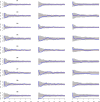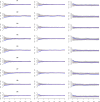Scale-dependent intraspecific competition of Taurus cedar (Cedrus libani A. Rich.) saplings in the Southern Turkey
- PMID: 31788215
- PMCID: PMC6875569
- DOI: 10.1002/ece3.5757
Scale-dependent intraspecific competition of Taurus cedar (Cedrus libani A. Rich.) saplings in the Southern Turkey
Abstract
Better understanding of the competitive interaction at the early development stages of the stand is crucial to help schedule silvicultural treatments for young stands and for the better management of the future stands. We used scale-dependent analysis to improve our understanding of sapling dynamics in the pure Taurus cedar (Cedrus libani A. Rich.) stands in Southern Turkey. Using data from nine plots established at the western Taurus Mountains, diameter, height, and crown radii of saplings were compared, and spatial point pattern analyses were performed. We found significant differences for the mean diameter and height, and crown radii of saplings among the plots. Univariate pair correlation function showed that sapling pattern was regular only at small scales (r < 0.4 m) but was predominantly random. Bivariate pair correlation function revealed no evidence of spatial interaction between tall saplings and short saplings. Univariate mark correlation function revealed that strong intraspecific competition was detected at small scales (up to 0.55 m). This distance is reasonable for the juvenile age tending of Taurus cedar saplings and should be under consideration during silvicultural treatments to use the site productivity more efficiently.
Keywords: Cedrus libani; intraspecific competition; mark correlation function; sapling; spatial interaction.
© 2019 The Authors. Ecology and Evolution published by John Wiley & Sons Ltd.
Conflict of interest statement
None declared.
Figures






References
-
- Aguirre, O. , Hui, G. , Gadow, K. V. , & Jimenez, J. (2003). An analysis of spatial forest structure using neighbourhood‐based variables. Forest Ecology and Management, 183, 137–145. 10.1016/S0378-1127(03)00102-6 - DOI
-
- Alptekin, Ü. , & Çalışkan, A. (1996). Türkiyede Saf Sedir Meşcerelerinde Uygulanan Silvikültürel İşletme Şekillerinin İrdelenmesi (Examination of the silvikültürel systems applied in pure Lebanon cedar stands of Turkey). DAOAE Dergisi, 2, 113–123.
-
- Anonim (2015). Orman Varlığımız. Ankara: OGM.
-
- Baddeley, A. , Rubak, E. , & Turner, R. (2015). Spatial point patterns: Methodology and applications with R. London, UK: Chapman and Hall/CRC Press; Retrieved from http://www.crcpress.com/Spatial-Point-Patterns-Methodology-and-Applicati...
-
- Başaran, M. A. , Başaran, S. , Baş, M. N. , Ms, K. , Tolunay, D. , Makineci, E. , … Deniz, İ. G. (2008). Elmalı sedir araştırma ormanında aktüel durumun coğrafi bilgi sistemi tabanlı sayısal haritalarla ortaya konulması. Antalya, Turkey: Western Mediterranean Forest research Institute.
Associated data
LinkOut - more resources
Full Text Sources

